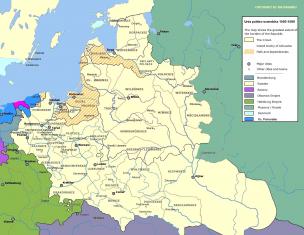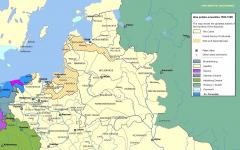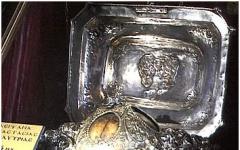In the animal world dark color It's not that rare anymore. This color helps in some conditions to gain advantages in the ability to hide and hunt, and in every possible way to fight for their place in the sun. But there are not so many truly black animals. Especially among mammals. Read our article about which animals are black (both wild and domestic).
Horses
Domestic animals tamed by humans since time immemorial primarily include horses. What color are horses (or rather, what colors)? The most different: light gray (white), red, nightingale (the body is red, and the mane and tail are white), brown (black-brown), bay (red-brown), piebald (based on the main color - white spots), gray , cowroy. And these are just the main ones. But the black horse is completely black. So to the question: “What animal is black?”, you can confidently answer: “A black horse.”

Cats
People treat cats with caution, cursing them and often accusing them of all mortal sins. But we, putting aside prejudices and superstitions, can state the fact that this color is found quite often in the color of pets (in some breeds - up to 50%). What animals are black? Domestic cats. Although some breeders avoid breeding black animals, they tend to perform better in competitions than non-melanistic breeds. For example, black Maine Coons have more pronounced characteristics of the breed: high-set ears and a longer muzzle. And melanistic Persians have the flattest “faces” and the smallest low-set ears. So, answering the question “what animals are black” among pets, we can say with confidence: “Cats of various breeds.”

The phenomenon of melanism
What animals are black? In fact, melanism occurs when normal conditions in many animals, not just mammals. Insects, fish, birds, amphibians and reptiles. All of them are subject to genetic deviations in color. Melanists are often called “albinos in reverse.” Among representatives of warm-blooded animals these are foxes, squirrels, cats, wolves, wild and domestic dogs. For many animals this is one of the ways of survival, and for the black jaguar, for example, it is an advantage during evening and morning (at dusk) hunting.
Black Jaguar. Description of the animal
A rather large animal whose skin, as a result of melanism (a genetic variant of coloration), is black. This animal of the subfamily of big cats is the only representative of the panther genus in the New World (Southern and North America). The distribution area is from Mexico to Paraguay. The length of its body (excluding the tail) reaches almost two meters, its weight can be up to one hundred kilograms. Height at withers - up to 70 centimeters. By appearance the predator is very similar to its other relative - the leopard, only larger in size.
It lives mainly in tropical and mountain forests, but is sometimes found on the ocean coast. It is a predator that hunts at dusk. The most active hours are after and before dawn, when the jaguar searches for its prey. These can be capybaras, peccaries, tapirs. But the predator does not disdain birds, rodents, and snakes. He also hunts various turtles (the jaguar is able to bite through even their hard shell with its powerful jaws), and also digs up turtle eggs and enjoys feasting on them. The jaguar is a good swimmer and can catch its prey in the water. Sometimes small sleeping alligators or fish become its prey.

The hunting method is to organize an ambush (in the grass, on paths, near water bodies). The jaguar jumps on top of the prey and tries to knock it down, sometimes breaking and biting through the skull. Experienced hunters (for example, in Brazil) attribute to the jaguar the ability to hypnosis in relation to their victims.
In jaguars living in dense forests, melanism is quite common (up to 50% of animals), since in low light conditions dark-colored animals are practically invisible, which makes it easier for them to hunt and survive. So to the question “What animal is black?” we can say with confidence: black panther. By the way, the fur (of panthers) is unevenly colored in this color, corresponding to the name. The spots that appear on the skin are more or less visible.
Animals are amazing creatures that never cease to amaze humanity. Fluffy fur white It is not found very often in animals, so it greatly attracts attention, literally captivating people with its beauty. And, nevertheless, this color allows animals to camouflage perfectly in order to save their lives or, conversely, for a successful hunt. White animals - photos and descriptions in our material.
Only those animals that live in the harsh Arctic and other places temporarily covered with snow have a white color. This article is dedicated to the ten most beautiful white animals.
White animals - photos and descriptions
White Wolfs
White animals - White wolves
Wolves are not only gray, as most people are used to seeing them. White wolves are only found in the Arctic, so to an ordinary person not destined to see them. Animals are spread throughout the Arctic, where they can find food. White wolves are perfectly adapted to the harsh Arctic climate, so they are not frightened by low temperatures, darkness, or even a temporary lack of food. The white fur of wolves with a slightly grayish tint helps the animals to hunt successfully, because it is thanks to this color that they can easily hide in the snow, and at the right moment they attack the prey, leaving it no chance of survival. Wolves feed on everything they find, since in the Arctic there is not much choice.
Snowy owls

White animals - White owls
Snowy owls are also called polar owls. The snow-white plumage of owls with black glimpses leaves no one indifferent. It’s not difficult to imagine such an owl, because everyone watched the Harry Potter films, after which polar owls gained popularity. Of the entire order of owls, white ones are considered the largest. It’s sad that today there are very few of these beauties left, since they are very important for the tundra: owls destroy rodents and pests, improve nesting for other birds, etc. Snowy owls are famous for their aggression, which, fortunately, they only show towards arctic foxes who want to kidnap little owls. Many tundra birds build their nests next to the nest of the polar owl, since it perfectly clears the territory of more dangerous predators, while never attacking other birds.

White animals - Arctic fox
Everyone knows this beautiful animal. The Arctic fox can safely be called one of the most beautiful white animals. Its soft and at the same time incredibly thick fur allows them to hide in the snow and withstand even the lowest temperatures. During heavy snow storms, Arctic foxes burrow into long tunnels, which they dig themselves. Unfortunately, gorgeous white fur appeals not only to animal lovers, but also to hunters who kill unfortunate animals for their fur.

White animals - Weasel
These animals have a beautiful white coat, which, fortunately, is not used by people. The animals are not caught because of their small size - about 20 centimeters in length, and they also emit a not very pleasant smell. The animals have a luxurious white coat only in winter, but in summer it turns whitish-brown, since in summer there is no need for the animals to hide in the snow. Weasel is a predatory animal that hunts small rodents and small birds. In general, the weasel feeds on everything it can catch, be it fish, snakes, insects, lizards or eggs of large birds. The animals are known for their agility, so they can easily crawl into any cracks.

White animals - Polar bears
Completely white fur can only be found on polar bears. Interestingly, the fur actually has no color, meaning it is transparent, and depending on how the light falls, it can take on a yellowish tint. Polar bears are distinguished from other types of bears by their flat heads, elongated necks and enormous size. Sometimes in wildlife There are even bears with greenish fur, which is associated with algae that attach to the hairs. Interestingly, bears have black skin.
Japanese macaques

White animals - Japanese macaques
White macaques are found only in northern Japan, and no other monkey species dares to settle in the areas where they live. In those parts of Japan, snow covers the land for up to 4 months of the year, so it helps the monkeys camouflage. By the way, otherwise monkeys are also called “snow monkeys,” although in fact they have gray fur, which saves them even in the coldest time of the year.
Arctic hare

White animals - Arctic hare
The white hare, like the weasel, is white only in winter, but the arctic hare always wears a white coat, regardless of the time of year. Only when the snow melts does the fur acquire a slightly bluish tint, which helps the hare better hide among the stones. The only thing that doesn't change all year round These are the ears and tail of a bunny.
harp seal

White animals - Harp seal
This animal changes its color several times throughout its life. The first few days after birth, babies are white with a slightly greenish tint; after a while, their color becomes completely white. Such a beautiful color does not last long, since after the first molt the babies acquire the same shade as adults - gray. When young, females and males have spotted skin, and when they become sexually mature, they develop two black stripes on their sides. These animals are rightfully considered one of the most beautiful white animals.
Snow Leopard

White animals - Snow leopard
Wild cats are very beautiful, especially if they have an unusual color. Such animals include the white leopard, which is also called the snow leopard. The leopard does not have pure white fur, its color has a slightly grayish tint, and, of course, the spots remain unchanged. IN summer time The leopard's color becomes much lighter, almost white, while the spots, on the contrary, darken.
White lions

White animals - White lions
A real miracle in a good way. White lions are not fiction, but real animals. Today, about 300 white lions are known, while in the 70s there were only 3. The white lion was first discovered by zoologists who went in search of the famous legend. Scientists took the three cubs and placed them in the sanctuary, thus marking the beginning of today's population.
- Cat;
- Panther;
- Dog;
- Puma;
- Bear;
- Wolf.
Correct answers to the game 100 to 1 to the question What animal is black...?:

The most popular answer comes first - cat- twenty-seven points;
In second place is the answer, the animal is black - panther- twenty-three points;
In third place the answer is - dog- nineteen points;
In fourth place the correct answer is - cougar- twelve points;
In fifth place the answer is - bear black - ten points;
In sixth place the answer is - wolf Available in black - nine points.
cat being searched for in a black room - 27 points
majestic wild panther -23 points,
a black dog (necessarily with a white ear) gets -19 points,
fast puma - 12 points,
scary dangerous black bear - 10 points in total,
predatory wolf - only 9 points for a terrible predator.
Many animals can be black, including a panther, a cat and a dog, and a horse. Here's what the correct answers to this question look like:
Here are all six correct options, and by answering, players will be able to quickly open the lines and win the game.
The correct answers to this question in the 100 to 1 game are:
cat - as many as 27 points, quite a lot,
panther -23 points,
the dog earns -19 points,
puma - 12 points,
bear - 10 points only,
wolf - 9 points.
In the popular game, there are 100 to 1 correct answers to the question: What animal is black? will be:
- cat;
- panther;
- dog;
- puma;
- bear;
- wolf.
This is exactly how the people surveyed answered. I wish you good luck in this game!
The correct answers to this question are a cat and a panther - the ones that came to almost everyone’s minds first. Next come the dog and the puma, followed by the bear and the wolf. Although I don’t quite understand the wolf’s answer, he still took 6th position. The most popular answers are not very complicated; you will only have to work hard on the last cells.

In 1st place cat- twenty-seven points;
In 2nd place panther- twenty-three points;
In 3rd place dog- nineteen points;
In 4th place cougar- twelve points;
The answer is in 5th place bear- ten points;
In 6th place will be wolf you will earn nine points.
1) cats are often black, although this is not their distinctive feature; cats can be gray, white, or multi-colored;
2) in second place is the panther;
3) in third place is a dog;
4) puma - an animal with black fur, in fourth place;
5) bears are often black;
6) and finally, the wolf. wolves also come in black colors
Black is in first place CAT.
Second place goes to black PANTHER.
Third place goes to black DOG.
Black was awarded fourth place PUMA.
On the fifth - black BEAR.
And on the sixth - WOLF.
There are a lot of black animals, you just have to open the list on Wikipedia and it shows a huge list of about a thousand or two different animals. The most popular ones are suitable for the game these are the answer options.
Correct answers to the game 100 to 1, there will be the following,
this question was asked What animal is black?.
27 points CAT;
23 points, you can earn money by answering - Panther;
19 points, you can earn money by answering - DOG;
12 points, you can earn money by answering - PUMA;
10 points, you can earn money by answering - BEAR;
9 points, you can earn money by answering - WOLF.

Quite a few representatives of the animal world are black in color, some are more familiar, some less so. Here are the black animals that the participants of the game remembered 100 to 1:
Animals that live in the Arctic are adapted to extreme conditions. Almost all of these animals have white skins. They not only help them hide in the drifts of white snow, but also give them incredible beauty and unusualness, unlike their counterparts that live in warmer climes.
polar Wolf(Canis lupus tundrorum) - subspecies of wolf. Inhabits the entire Arctic, with the exception of ice floes and large areas covered with ice.
The polar wolf lives in vast areas of the polar regions, which are immersed in darkness for 5 months. To survive, the wolf has adapted to eat any food that comes across. It is well adapted to life in the Arctic: it can live for years at sub-zero temperatures, go months without seeing sunlight, and go weeks without food.
For centuries, people have mercilessly exterminated wolves of all varieties. However, the polar wolf is the only subspecies that still lives throughout the entire territory that was accessible to its ancestors. This happened because people rarely get here.




Arctic fox, the polar fox (lat. Alopex lagopus or lat. Vulpes lagopus) is a predatory mammal of the canine family, the only representative of the genus of arctic foxes (Alopex). The arctic fox lives in some of the coldest places on the planet. The Arctic fox is an incredibly hardy animal that can survive cold arctic temperatures down to -58°F (-50°c). It has fluffy fur and short ears to survive in such low temperatures. Arctic foxes live in burrows, and in a snowstorm they can dig a tunnel in the snow to create a shelter. Arctic foxes have beautiful white (sometimes blue-gray) coats that act as very effective winter camouflage. Natural shades allow the animal to blend into the ubiquitous snow of the tundra.




White Owl- the largest bird from the order of owls in the tundra. The head is round, the iris of the eyes is bright yellow. Females are larger than males. The body length of a male can reach 55-65 cm, weight - 2-2.5 kg, females, respectively, 70 cm and 3 kg. The wingspan averages 142-166 cm. The coloring is protective: adult birds are characterized by white plumage with dark transverse streaks. Females and young birds have more streaks than males. Chicks Brown. The beak is black, almost completely covered with bristle feathers. The plumage of the legs is similar to wool and forms “braids.” Snowy owls play a key role in the tundra biota, being one of the main exterminators of rodents, as well as a factor in the successful nesting of some tundra birds. Using the extreme aggressiveness of snowy owls to protect the nesting territory, ducks, geese, geese, and waders nest on it. Owls do not touch birds, but they successfully drive away arctic foxes that destroy nests from their territory. It is listed in the Red Book.




It’s a harsh winter outside, but not all the animals took refuge from it in cozy holes, falling into hibernation. In addition to the classic wolf, fox and hare known from childhood according to fairy tales, representatives of the mustelid family are awake in the winter forests. The smallest mustelid is an animal called weasel. The weasel received such an apt description as “a thunderstorm of mice.” This animal is the only mustelid that has no commercial significance due to its small size. With a length of 20 centimeters, 4.5 cm is accounted for by a short tail. Like a ferret, the weasel is a rather smelly animal. First you smell it, then you see it. In winter, the weasel is completely white, the color of snow, and in summer it is white and brown. Moreover, the edge of the upper lip, the entire lower side of the body and internal sides paws The weasel is primarily a nocturnal animal, but where it sees no danger for itself, it can hunt during the day. Among the mammals, the animal's prey consists of house mice, field mice, and forest mice. Of the birds, the weasel feasts on larks and other birds living on the ground, as well as pigeons and chickens, if it gets into the chicken coop. She does not disdain lizards, frogs, fish and snakes. It can attack a viper, although the bite of this weasel snake is fatal. All kinds of insects are a delicacy for her, and she can even cope with the hard shell of a crayfish when she comes across one on occasion. The weasel runs, jumps, swims and climbs trees well. Its ability to crawl through the narrowest cracks and holes is its main strength. Thus, weasel easily pursues mice in their own burrows. The weasel grabs small animals by the back of the head or head, and tries to grab onto the neck of large ones. She skillfully makes one or several holes in bird eggs and sucks out their contents without losing a single drop.



![]()
Arctic hare(lat. Lepus arcticus) - a hare, mainly adapted to living in polar and mountainous areas. Previously, it was considered a subspecies of the mountain hare, but is now recognized as a separate species.


Snow monkeys.


Snow leopard.


Polar bear, oshkuy (lat. Ursus maritimus) is a predatory mammal of the bear family. Sometimes this species is classified as a separate genus Thalarctos. The Latin name Ursus maritimus translates as “sea bear.” The polar bear is the largest terrestrial representative of mammals of the order of carnivores. Its length reaches 3 m, weight up to 800 kg. Males usually weigh 400-450 kg; body length 200-250 cm, height at the withers up to 130-150 cm. Females are noticeably smaller (200-300 kg). The smallest bears are found in Spitsbergen, the largest in the Bering Sea. The polar bear is distinguished from other bears by its long neck and flat head. His skin is black. The color of the fur coat varies from white to yellowish; In summer, the fur may turn yellow due to constant exposure to sunlight. The polar bear's fur is devoid of pigment color and the hairs are hollow. There is a hypothesis that they act as light guides, absorbing ultraviolet rays; in any case, in ultraviolet photography the polar bear appears dark. Due to the structure of the hairs, a polar bear can sometimes turn green. This happens in hot climates (in zoos), when microscopic algae grow inside the hairs.




harp seal, or coot (lat. Phoca groenlandica, lat. Pagophilus groenlandicus) is a common species of true seals (Phocidae) in the Arctic. A pronounced inhabitant of cold waters, but avoids the Arctic pack, preferring drifting ice. Makes holes in the ice. Makes wide seasonal migrations. During the periods of breeding and molting, it rests on ice. Not a strict monogamist. Harp seals live in herds, the age and sex composition of which varies throughout the year. There are fights between males during the mating period. Pupping occurs in strictly localized areas (<детных>ice). In communication, acoustic and visual signals are of primary importance. It feeds on pelagic invertebrates and fish. Mating occurs in March. Pupping was noted at the end of February - beginning of March. Pregnancy is 11.5 months; there is a long latent stage in the development of the embryo. Usually 1 cub is born, covered with thick, long white fur (squirrel) with a greenish tint (the tint disappears a few days after birth). The weight of the newborn is 7-8 kg. After a week, the squirrel begins to molt (Khokhlushi stage); a completely moulted baby is called a serok. Left maturity reaches 4.5 years.




Reindeer - Rangifer tarandus. The reindeer has an elongated, squat body (length 180-220 cm, height at the withers 100-140 cm). There is a short, not always noticeable mane on the neck, and an elongated muzzle. The color is brown in summer, gray in winter, lighter in tundra deer. The mane is white in winter. Small fawns are single-colored, only in Southern Siberia do they have white spots along the back. Both males and females have horns. They are very long, thin, crescent-shaped; the lateral processes are located on the outer (back) side of the trunk, and not on the inner (front), as in real deer.
At the ends of the antlers, and often in front of their base, there are small triangular shovels with processes. Domestic deer are difficult to distinguish from wild ones, but in their herds there are much more white and spotted animals. In addition, they have almost no fear of humans, while wild deer (sokjoi) are usually very cautious. The eyes of a reindeer glow with a dim yellowish light at night. When reindeer move, a peculiar clicking sound is heard, by which you can recognize the approach of a herd at night from hundreds of meters away.










